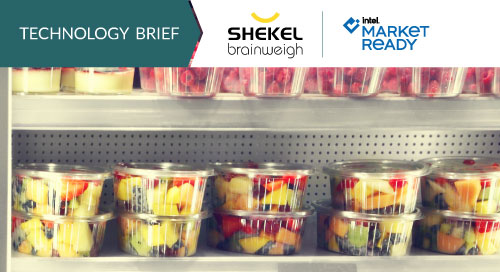AI Opens the Door to Smart Vending Machines

If you want to grab a snack and go, the convenience of a vending machine is hard to beat. But today’s shoppers want more. They prefer fresh food, like salads, cheese, and yogurt, which aren’t usually sold in traditional machines. And maybe an occasional cookie—but only if the calorie and sugar count is acceptable. If it’s locked inside a vending machine, who knows?
Retail businesses are frustrated, too. They don’t have a good idea of what’s selling and what’s not, and they often don’t spot problems until it’s too late. Today, a new generation of smart vending machine systems is helping to solve these problems, offering customers a more convenient shopping experience, while providing better information and new opportunities for retailers and brands.
Technology developed by Shekel Brainweigh, a retail technology innovator, allows customers to open the door of its innovative, intelligent vending machine and inspect products before they buy. And real-time information about their interactions and purchases can be sent to machine operators and retailers. Shekel partnered with refrigerated-products manufacturer Imbera Cooling and vending machine management company Parlevel Systems to deliver its smart-cooler solution called hubz.
For shoppers, the hubz experience is radically different from using a traditional vending machine.
Point-of-Sale “Home Fridge”
“With a traditional machine, you press F6 and you get one product. With our machine, you open the door and take as many products as you want,” says Eliran Vaknin, Head of Product for Shekel Brainweigh Retail Innovation Division. “You can look at the expiration date, read the nutritional information, and put something back if you don’t want it. It’s like using your fridge at home.”
Except to get into this fridge, you need a credit card, debit card, an app such as Apple Pay, Google Pay, or a brand loyalty mobile app. “That will identify you, and after that, you cannot take anything from the shelf without us tracking it,” Vaknin says.
Shekel uses two tracking technologies. The first is its secret sauce—a custom IoT load sensor that accurately identifies products by their weight. “Shekel is a 50-year-old company with expertise in weighing solutions,” explains Rami Behar, the company’s Chief Business Development Officer.
The second technology uses AI-embedded software algorithms to track the exact location of products as they travel from the shelf to the customer’s hand and out the glass door—or back onto the shelf if the customer changes their mind (Video 1).
For retailers, giving customers better choices and allowing multiple-item transactions boosts profits. Fresh food also sells at higher prices, and consumers are more likely to buy it if they can inspect it first.
“On average, hubz coolers double the sales of standard vending machines that were in the same place,” Behar says.
Receiving up-to-the-minute information about transactions and customer preferences allows retailers to better predict sales and understand trends. @ShekelLtd via @insightdottech
Improving Operations with Retail Analytics
Streaming data gives retailers and machine operators better control over inventory management. With hubz, an Intel®NUC small form-factor PC is embedded in the cooler, then processes and sends data about a product’s journey from the time a customer picks it up until it is purchased or replaced.
A second Intel® processor-based computer relays information about inventory and transactions, including customer conversion rates. It also alerts operators if the cooler’s temperature is off or the door is left ajar—problems they can fix remotely.
Receiving up-to-the-minute information about transactions and customer preferences allows retailers to better predict sales and understand trends. They can test new products, rearrange planograms, and do shelf placements on the fly, instead of basing decisions on information delivered weekly by technicians. Those who use an app for transactions can also offer customers on-the-spot targeted promotions.
AI Technology Helps Brands
Retailers aren’t the only ones who profit from insights about customer behavior.
“This is very valuable information for consumer packaged-goods (CPG) companies,” Behar says. The ability to sell products 24/7 without incurring labor costs or dealing with intermediaries is a huge draw for manufacturers.
These advantages—and the elimination of the soft-food-squashing mechanical arms found in traditional vending machines—tipped the scales for Israeli dairy producer Tnuva. It decided to try selling its milk, cheese, yogurt, and other dairy products directly to consumers for the first time, using Shekel’s smart cooler.
When a trial of 40 coolers proved successful, Tnuva began rolling out 100 more, placing them in office buildings, fitness centers, train stations, hospitals, and other high-traffic public locations. What they learned surprised them.
“It was totally different from the regular vending machine experience,” Vaknin says. “Peak sales were not at snack times, but at 5 or 6 p.m., when people were finishing up work and decided to collect some milk and cheese for the evening meal. Usually, they bought two or three products. It was like a replacement for a local convenience store.”
Tnuva smart coolers now handle tens of thousands of transactions per month. Streaming data is sent to a central cloud-based dashboard, where it is analyzed to reveal trends. Centralized control also simplifies management and makes scaling easier.
Like its customers, Shekel continues to learn from the information collected by its machines.
“We are gaining lots of data over time from every purchase and every customer trial. That helps us keep improving our algorithm technology,” says Vaknin. “This is the future of convenience shopping.”
This article was edited by Christina Cardoza, Associate Editorial Director for insight.tech.
This article was originally published on March 22, 2021.